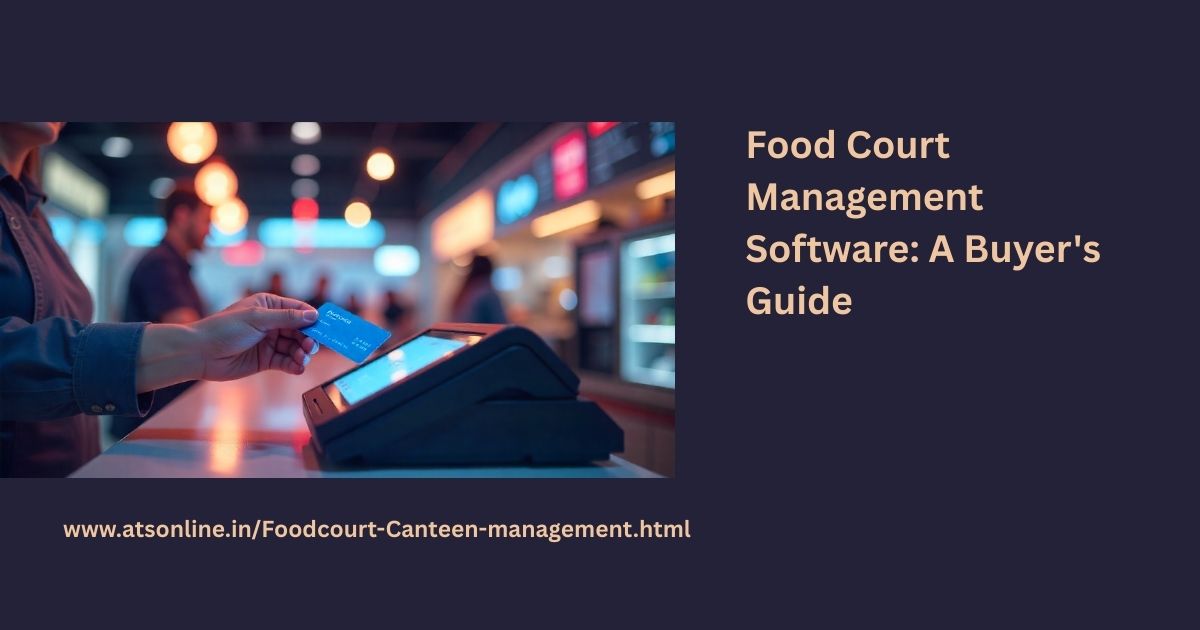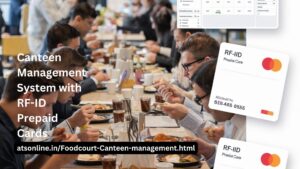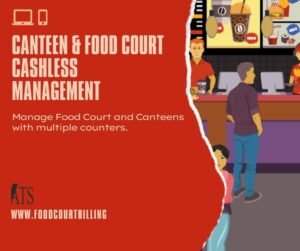Choosing a food court management software? Our guide covers essential features like offline prepaid cards to help you reduce queues, boost revenue, and improve security.
The lunch rush hits. Suddenly, your food court transforms from a calm dining area into a chaotic maze of queues. Cash is being fumbled, credit card machines are lagging, and frustrated customers are checking their watches. For food court owners and managers, this isn’t just a daily headache—it’s a direct hit to your bottom line and reputation.
The solution lies in upgrading your operational core, and that starts with choosing the right food court management software. But with so many options, how do you separate the essential tools from the expensive novelties?
This guide will walk you through the non-negotiable features your software must have. More importantly, it will reveal why a specific technology—the offline prepaid card system—isn’t just a feature, but a fundamental game-changer for modern food court operations.
Why Your Old POS System is Costing You More Than You Think
Before diving into the solution, let’s diagnose the problem. If you’re still relying on traditional cash registers or a basic, single-vendor POS system, you’re likely facing:
- Slow Transactions: Cash handling and individual credit card processing at every stall creates massive bottlenecks.
- Security Risks: Cash invites theft and errors, while paper coupons are notoriously easy to counterfeit.
- Reconciliation Nightmares: Manually calculating each vendor’s sales at the end of the day is a time-consuming, error-prone administrative nightmare.
- No Real Data: You have little to no insight into which vendors are performing best, what your peak hours truly are, or what your customers are buying.
A modern food court management software is designed to solve all these problems at once.
The Essential Checklist for Choosing Food Court Management Software
When evaluating a new system, don’t get lost in a long list of minor features. Focus on the core pillars that will deliver the biggest impact. Here’s your essential checklist.
✅ 1. A Centralized Cashless System (Prepaid Cards)
This is the heart of an efficient food court. Instead of transactions happening at every stall, the entire payment ecosystem is unified. Customers load funds onto a prepaid card at a single, secure station. They then use this card for “tap-and-pay” purchases at any food counter. This simple change is the foundation for almost every other benefit on this list.
✅ 2. Absolute Offline Reliability
This is the single most critical feature, and it cannot be overlooked. What happens when your food court’s internet connection inevitably lags or drops during the busiest hour of the day? With an online-only system, your entire operation grinds to a halt. Sales stop. Queues explode. Chaos ensues.
An offline-first food court management software is your insurance against this disaster. It processes every transaction locally on the terminal, ensuring 100% uptime and speed, regardless of internet stability. The data simply syncs to the central server when the connection is restored. For a high-volume environment, this isn’t a luxury; it’s a necessity.
✅ 3. Robust Multi-Vendor Reporting
A food court is a collection of separate businesses operating under one roof. Your software must be able to track sales, taxes, and transaction data for each vendor independently. Look for a system that provides clear, automated reports you can use to simplify vendor payouts and analyze individual performance.
✅ 4. Iron-Clad Security and Access Control
The system should eliminate common avenues for fraud. By centralizing cash at a single recharge point and making all other transactions digital, you drastically reduce the risk of theft. Furthermore, ensure the software has role-based access controls, so cashiers and managers only have access to the functions they need.
✅ 5. An Intuitive, User-Friendly Interface
The best software is useless if your staff can’t use it. The POS interface at each vendor stall should be incredibly simple, with large buttons and a clear workflow. Training for a new cashier should take minutes, not hours.
The Game-Changer: How Offline Prepaid Cards Revolutionize Operations
Now that you know what to look for, let’s explore why this model is so transformative.
1. Eradicate Queues and Boost Sales
A tap-and-pay transaction takes 2-3 seconds. A cash or credit card transaction can take up to a minute. By multiplying that time saved across hundreds of customers, you dramatically increase your throughput. Shorter queues lead to more sales and happier customers who aren’t afraid to return during peak times.
2. Unlock New Revenue Streams
This is a benefit that managers often overlook. When a customer loses a card or leaves a small balance on it and doesn’t return, that unused money (known as “breakage”) is retained by your business. Across thousands of cards, this becomes a significant, direct-to-profit revenue stream that simply doesn’t exist with other payment methods.
3. Simplify Vendor Management and Payouts
With a centralized system, you no longer need to manually collect sales data from each vendor. At the end of the day or week, you can run a single report that shows exactly how much each vendor earned. Payouts become a simple, transparent, and accurate process, fostering better relationships with your tenants.
Choosing the Right Partner for Your Food Court
Selecting a food court management software is a major business decision. The ultimate goal is to find a system that is fast, reliable, and secure. As this guide shows, a solution built on an offline, prepaid card architecture is uniquely positioned to deliver on all three fronts. It directly solves the biggest pain points of a multi-vendor environment while creating new opportunities for revenue and efficiency.
When you invest in the right technology, you’re not just buying software; you’re buying a calmer, more profitable, and more professional operation.
We hope you enjoyed reading our blog posts about food court and canteen prepaid card billing solutions. If you want to learn more about how we can help you manage your food court business, please visit our website here. We are always happy to hear from you and answer any questions you may have.
You can reach us by phone at +91–9810078010 or by email at ats.fnb@gmail.com. Thank you for your interest in our services.
Frequently Asked Questions (FAQ)
1. How is a prepaid card system better than just using standard credit card terminals at each stall?
While credit card terminals are common, a centralized prepaid card system offers three key advantages for a food court environment:
- Speed: A tap-and-pay transaction with a prepaid card takes 2-3 seconds. A credit card transaction (insert/tap, connect to bank, process, print receipt) is significantly slower, creating bottlenecks during peak hours.
- Centralized Data: All sales data from all vendors is consolidated into one system, making end-of-day reconciliation and vendor payouts incredibly simple.
- Revenue Capture: You can implement policies to retain unused balances from lost or expired cards, creating a new revenue stream that isn’t possible with standard credit cards.
2. What happens if our food court’s internet connection fails? Can we still process payments?
Absolutely. This is the primary advantage of choosing an offline food court management software. Our system is designed to be 100% operational without an internet connection. Every transaction is securely stored on the local POS terminal and automatically syncs with the central server once the connection is restored. This means you have zero downtime, zero lost sales, and zero customer frustration during an outage.
3. What is the typical ROI for a food court management software with prepaid cards?
The return on investment (ROI) is strong and comes from several areas:
- Increased Customer Spend: Studies show that customers spend 15-20% more on average when using a cashless method compared to physical cash.
- Breakage Revenue: You retain the full value from funds left on lost or expired cards.
- Reduced Labor Costs: Time spent on manual cash counting, reconciliation, and vendor report generation is drastically reduced.
- Fraud Elimination: You completely eliminate losses from counterfeit paper coupons and cash handling errors or theft.
4. Will my vendors and staff find this system difficult to learn and use?
Not at all. The system is designed for simplicity and speed. The vendor-side POS interface is highly intuitive, with large, clear buttons for menu items. We find that staff can be fully trained and confident in using the system in under 15 minutes. For vendors, the benefits are clear: they serve more customers, have no cash to manage, and receive fast, accurate sales reports.
5. What happens when a customer loses their prepaid card or has a balance left over?
Our food court management software includes features to handle this smoothly. If a customer has registered their card, an administrator can quickly deactivate the lost card and transfer the remaining balance to a new one. For leftover balances, you can set your own business policies, such as allowing customers to get a refund (minus a small administrative fee) or setting an expiration date for the card balance.




